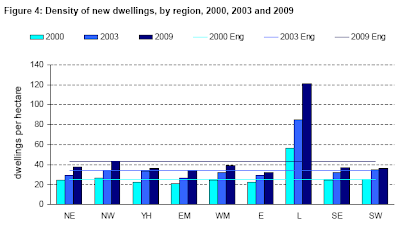Looks bad! But wait, the City report says:
However the numbers of cyclists riding into the City has significantly increased, so that the actual casualty rate is falling.Except they don't try to quantify the 'casualty rate'. So I thought I'd have a go.
Chapter 1 of the City's Draft Local Implementation Plan includes another trend chart, this one showing the number of cyclists counted crossing the City boundary on a single day in a given year [1].
To save you squinting, those numbers are:
1999 7,664
2002 9,565
2005 15,425
2007 16,030
2010 24,888
I combined the two, added a linear interpolation for missing years, and also linear trends for each time series, to get the following.
It's tempting to look at the two parallel trend lines and conclude that the relationship between cycle trips and KSI has not really changed, but that would be wrong, as the cyclist count was starting from a relatively low base so has actually increased by a higher percentage.
Another way to look at it is to isolate the years for when we have both count and KSI data, as in the table below [2]. Unfortunately there are only four of these and the most recent is 2007.
It is hard, and possibly foolhardy, to try and extrapolate a trend from so little data (but the same surely applies to the City's take on the figures). There certainly looks to have been a reduction from 1999 to 2002, but then no sign of any further fall in the five subsequent years.
This tallies somewhat with analysis carried out by Ben Lewis of TfL, who calculated cyclist accident exposure rates in Inner and Central London based on TfL counts at a large number of different sites and found a non-linear relationship between the number of cyclists at a particular location and the accident rate (see chart below).
The dashed vertical lines indicate current levels of cycling in each part of London. What the chart shows is that the accident rate is lower in Central London than in Inner London (perhaps partly due to 'safety in numbers') but is in danger of bottoming out in the absence of substantial additional safety measures.
This trend, or rather lack of trend, should be of great concern to the City. Cyclists accounted for 19 of the 46 KSIs in the City in 2009 (table 3.10 here), and in its draft LIP it has set out one target to grow the number of cyclists entering from 24,888 in 2009 to 36,300 in 2013, and another target to reduce the total number of KSIs to 37 by 2013. But if cycling does grow to 36,300 trips and the accident rate doesn't fall any further, from my table above we would expect to see 27 or so cyclists killed or seriously injured in a given year. It seems unlikely that non-cyclist KSIs (most of them pedestrians) will fall from 27 to only 10 in such a short period, in which case the KSI target won't be met.
In fact, the accident rate for either cyclists or pedestrians is going to have to fall dramatically if the City is going to meet both its target to grow cycling numbers and reduce the numbers killed or seriously injured. There is little sign in the draft LIP that the City is really considering any measures that are going to dramatically improve conditions for cyclists and pedestrians, so right now it seems extremely unlikely that it is going to achieve both of its targets. Something is going to have to give - the question is, will we see the growth in cycling tail off, or continue upwards at the expense of yet more cyclists killed or maimed on the City streets?
[1] There is frustratingly little information given about this count (Is is just cyclists entering the City, or all boundary crossings? Is the count always at the same site? Is it measured just once a year or averaged over several days?), so we just have to assume that the methodology is consistent from year to year.
[2] Note that the size of the figures in the final column isn't that meaningful, since it divides an annual figure (KSI) by a daily figure (cycle count).






